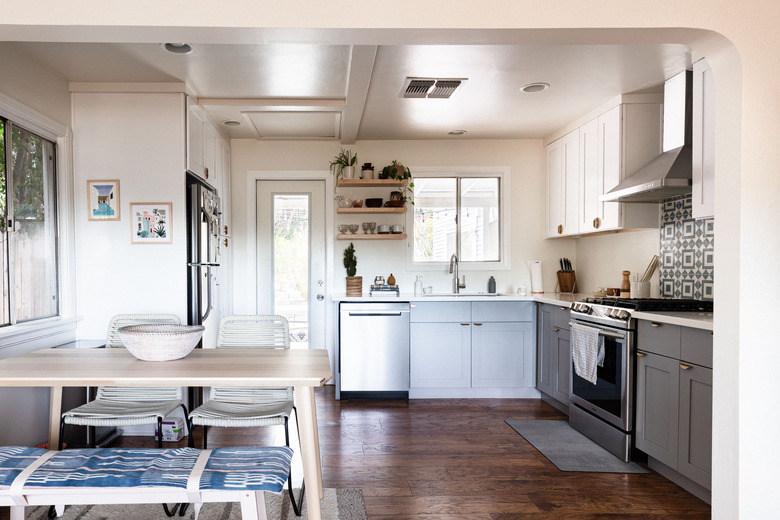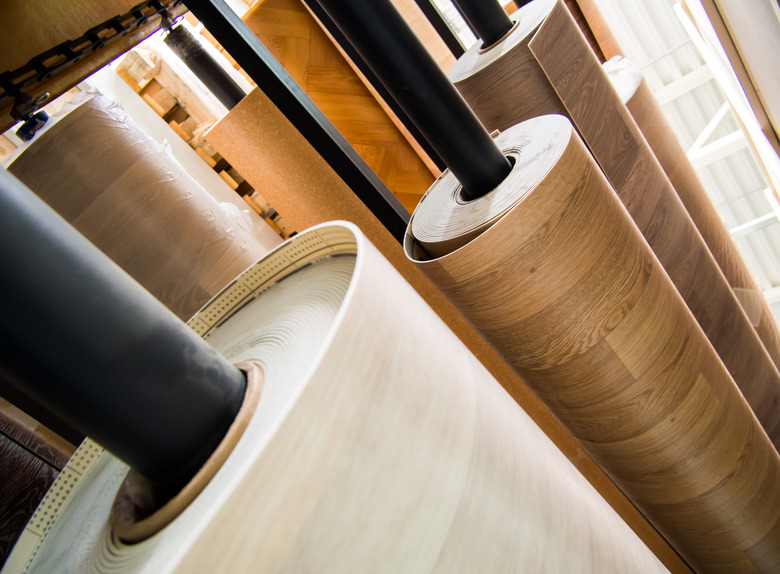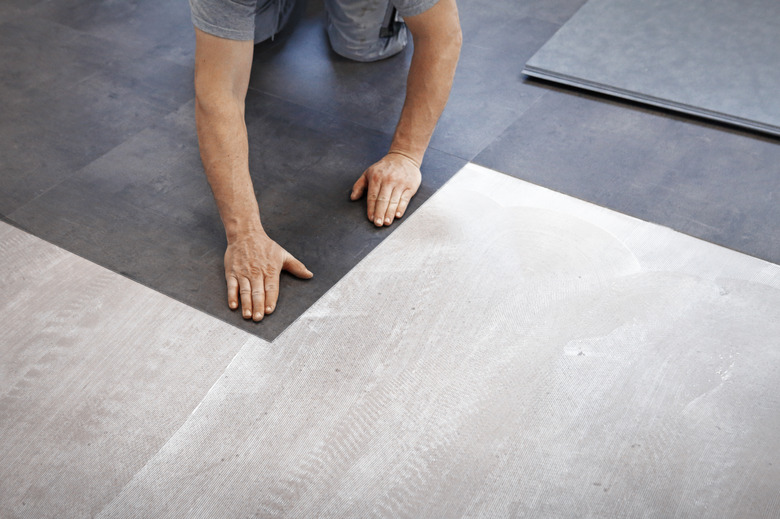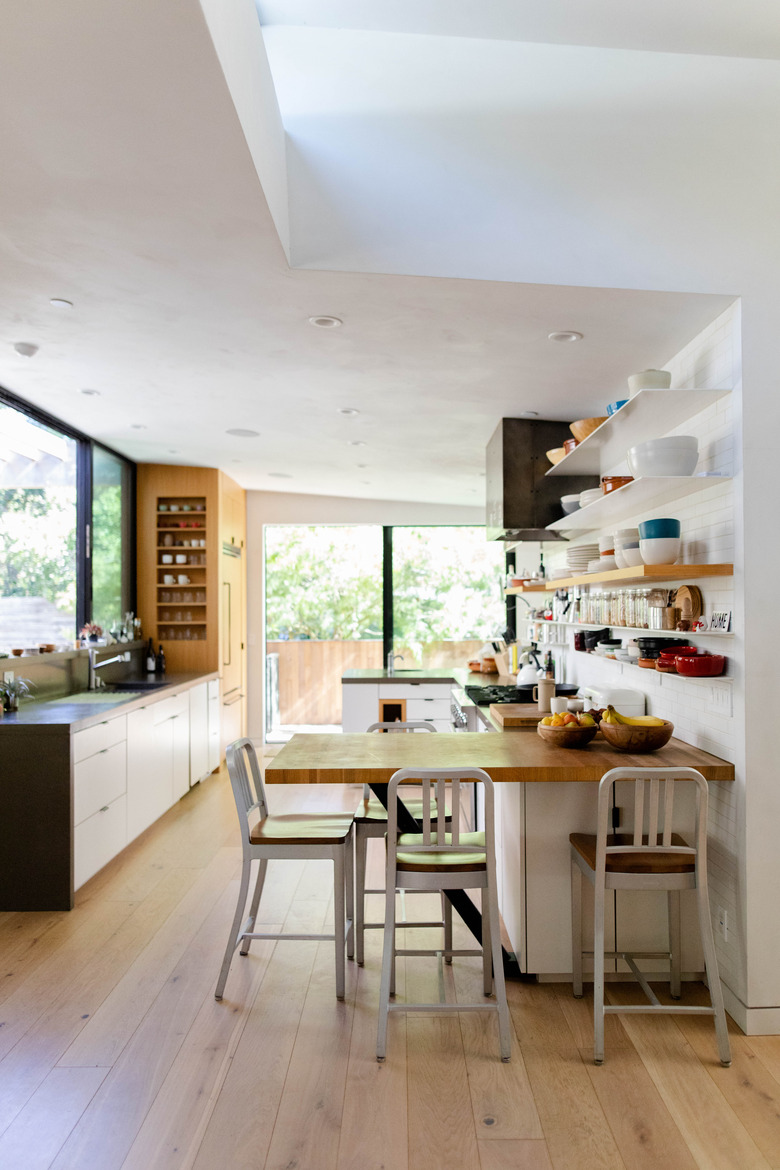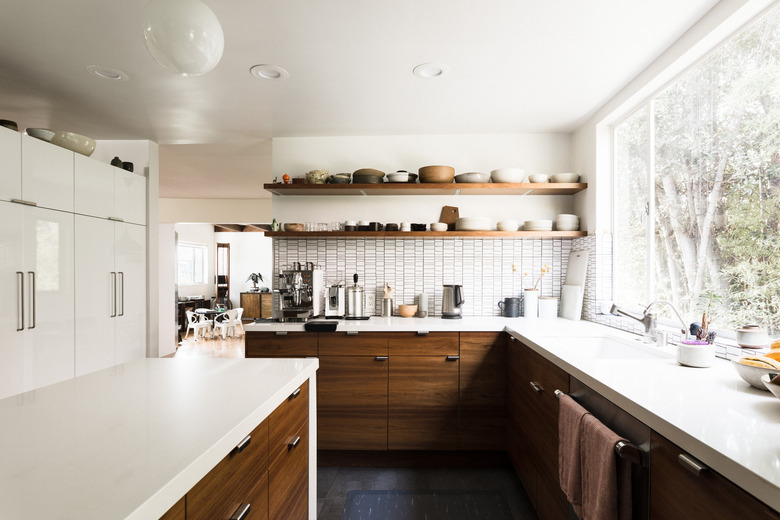Vinyl Kitchen Flooring: What You Need To Know
Vinyl flooring is a popular and sensible choice for kitchen flooring. It is relatively durable, moisture resistant, inexpensive, easy to install, low maintenance. It's available in a rapidly expanding array of forms and patterns that are squarely on trend today, according to industry authorities like Flooring Inc. It is also comfortable under your feet and is pretty forgiving if you drop a breakable item onto it. If you are contemplating a new kitchen floor, vinyl is certainly worth a close look.
There are, however, a few negatives about vinyl flooring options for a kitchen (or any other room). From a green standpoint, they are not natural products. They normally cannot be recycled after removal and if burned, they release highly toxic gases. In fact, the chemical content of vinyl flooring ranks it among the more hazardous flooring choices, according to experts at the Healthy Building Network.
Off-gassing of chemicals into the environment can be a nuisance if not a hazard with vinyl kitchen flooring, although manufacturers have made strides in addressing this. On the flooring packaging, look for certification labels such as FloorScore, which is granted to products that meet environmental standards.
Types of Vinyl Flooring
Types of Vinyl Flooring
Vinyl flooring fits into the larger category of resilient flooring, with linoleum, cork and rubber being the other principal products in the category. It has been around since the 1960s and has grown to control a significant percentage of the flooring marketplace, especially for kitchens, bathrooms and basements. The most familiar form remains sheet vinyl, which is usually sold by the lineal foot in 12-foot-wide rolls.
Vinyl tiles, traditionally 12 x 12 inches, are a popular option for kitchens, including both composite tiles that are bonded down with adhesive and self-adhesive "sticky-back" tiles that you simply peel and stick to the underlayment (perhaps the easiest flooring installation for any beginning homeowner). You can also find homogeneous vinyl tiles that look like linoleum and are constructed from a solid layer of vinyl. Newer additions to the vinyl flooring market include luxury vinyl planks and luxury vinyl tile as well as composite and self-adhesive tiles in new size options.
Sheet Vinyl: Perfect for Kitchens
Sheet Vinyl: Perfect for Kitchens
Seamlessness and low maintenance make sheet vinyl a solid flooring option for kitchen installations. Unless your kitchen is wider than 12 feet in both directions, you can install it in a single piece, which is a nice safeguard when you spill the spaghetti water.
Although some thicker resilient sheet goods can be loose-laid with glue only around the edges, in almost all kitchen installations, it is recommended that sheet vinyl flooring be fully bonded to the underlayment. This makes it a somewhat more complicated job than laying vinyl tile for the DIYer. Check with the flooring manufacturer to find out which adhesive to use, as some adhesives may have negative reactions with some backings.
Most building centers carry a limited selection of sheet vinyl patterns. Although the patterns are updated occasionally, many of them tend to look dated. However, if you order through a flooring distributor or even special order from your building center, you'll find a host of designs and even unique possibilities. Many utilize surface textures or glossy topcoats to enhance the visual effect and feeling underfoot if they are trying to replicate wood or stone floors.
Sheet Vinyl Quality and Cost
Sheet Vinyl Quality and Cost
Sheet vinyl is a layered product that comes in a variety of thicknesses, generally from 0.08 inches to 0.10 inches. Product thickness is not necessarily an indicator of quality because it is determined mostly by the backing, which is made from treated paper, wood pulp or fiberglass.
Instead, sheet vinyl quality and durability are determined largely by the thickness of the top wear layer, which can range from as little as 6 millimeters up to 20 millimeters. Common wear-layer thicknesses are 10, 12 and 15 millimeters. Made from multiple layers of urethane or clear PVC film, thicker wear layers last longer, better resist scuffing and are less likely to be cut or scratched to affect the pattern film layer beneath.
Costs for sheet vinyl can be less than $1 per square foot at some larger building centers. These tend to have very thin wear layers. Other off-the-rack products are in the $1 to $2 range. Higher-quality sheet vinyl products with thicker wear layers sell for $3 to $5 per square foot.
Old-Style Vinyl Tile
Old-Style Vinyl Tile
For a generation or two, you had two choices when it came to vinyl tile: self-adhesive or glue-down. They were almost all 12 x 12 inches. Pattern choices were limited and updated infrequently. However, if you were looking for a cheap and easy flooring solution, vinyl tile was the way to go. These first-generation products are still available, but the pattern and size options have expanded quite a bit, including updated patterns and larger 18 x 18-inch tiles.
As a floor covering, vinyl tile remains popular, especially the "sticky back" or peel-and-stick self-adhesive tiles. On sale, you can still find them for as little as 50 cents per tile, although the $1 per tile range is more typical. As long as the surface on which you are putting them is clean and smooth, you simply peel off the backing and press down each tile. Some care is required, and gaps and misalignments will be noticed.
If you are planning a checkerboard kitchen or pantry floor, for example, and longevity is not a priority, sticky backs could be a good solution. For a kitchen, the only real benefits they offer are ease of installation and economy.
Homogenous vinyl tiles, also called composition tiles, are rolled from solid material and are not laminated. They look and feel like linoleum tiles and are most frequently installed in hospitals, churches, schools and commercial buildings. However, they can function well in a kitchen, especially if you are trying for a retro look. They require full bonding to a smooth underlayment. They do not have wear layers like other vinyl tiles, so regular waxing, stripping and re-waxing is required to maintain a gloss and prevent scratching.
Luxury Vinyl Flooring
Luxury Vinyl Flooring
Newer vinyl flooring products mostly fall into the luxury vinyl flooring (LVF) group. These can include various plank-shaped luxury vinyl planks (LVP), usually resembling hardwoods (traditional and exotic) or rustic/reclaimed barn wood in look and in texture. Others, typically square luxury vinyl tiles (LVT), imitate stone or masonry surfaces.
Although LVF products carry the "luxury" adjective, product quality is far ranging. On the high end, they are very convincing and durable and are among the most interesting and impressive vinyl floors you can install in a kitchen.
Look for LVPs or LVTs with beveled, painted edges. Depending on the pattern, these can look more realistic and are a bit more forgiving to install than straight-edged products. Also, some of the click-together products have a pre-attached pad on the bottom so you can install them without laying a typical floating floor pad.
Most LVF planks and tiles costs from $3 to $5 per square foot, although some of the thicker, premium products can run $8 per square foot or more.
Luxury Vinyl Planks
Luxury Vinyl Planks
Designed to look like real wood flooring (generally not recommended for a kitchen), LVP products have the advantage of the material being completely waterproof, so in that sense, they are better than real wood. Also like most vinyl products, they have "give" that causes less fatigue if you are standing in front of the sink for a long time. However, like other plank flooring types, LVP does have vulnerabilities at the seams. If your kitchen gets heavy use and is exposed to moisture — including wet mopping — then plank flooring of any type is not the best long-term choice.
LVP products are typically 4 to 8 inches wide and 3 or 6 feet long. You will also encounter LVPs that are 12 x 24 inches and still feature wood grain patterns. Some manufacturers call them planks, and others call them tiles.
Inexpensive LVP products can be as thin as 2 millimeters, are highly flexible and usually have a self-adhesive backing. Higher-grade LVPs are as beefy as 6 to 8 millimeters, with extra-thick wear layers up to 20 millimeters. Most of the higher-end vinyl planks have "click" edges so they snap together and float on a sponge or fabric underlayment in much the same way as laminate flooring.
Luxury Vinyl Tile
Luxury Vinyl Tile
LVT are solid vinyl tiles that normally feature a marble, granite or concrete pattern. Although impervious to moisture, they have even more seams than planks, which can work against them as kitchen flooring. They come in click-together, self-adhesive and glue-down forms with straight or beveled edges.
You can overcome the leaky seam issue encountered with LVT by installing them 1/8 to 1/4 inch apart and filling the gaps with elastomeric "grout" designed specifically for these products and usually sold next to them on the shelves. This fake grout creates a seal and enhances the stonework or tile effect. Look for LVTs with beveled edges if you will be "grouting."
LVTs with straight, vertical edges are intended to be pressed flush against one another when installed. This creates a contiguous, unbroken appearance like you would typically find with real marble tiles. The overall effect is traditional and formal.
